In an English Country Garden (Part 2)
A tale of two rank amateurs attempting to work with Nature. In which we discover that 'The best-laid schemes of mice and men gang aft agley'*
ENVIRONMENTECO-GARDENING
12/13/20246 min read
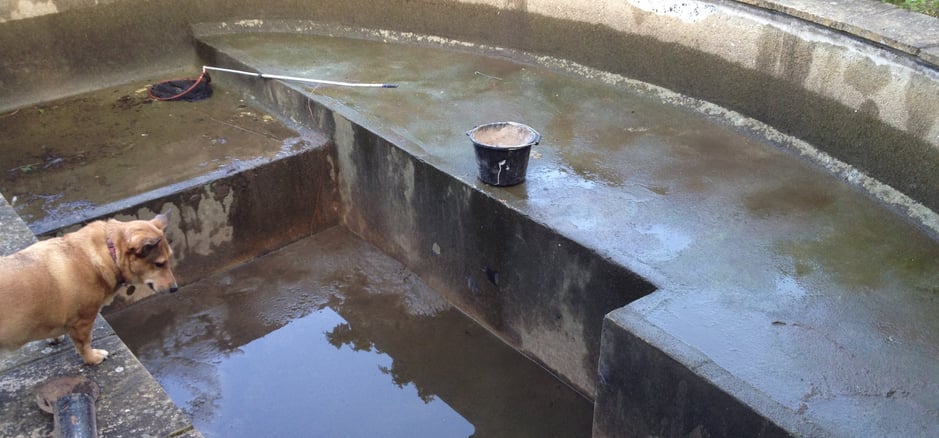

The pond of doom being inspected by Tansy
In the first part of this series I looked at the basic layout of the Garden, it's location, climate and the challenges it presented. In the second part I'll cover the changes we have made so far... but I'll start with the changes we didn't expect to make...
Trials and Tribulations:
1) The 'Pond of Doom'
When we moved here in late 2011 we obviously knew about the large pond just outside the patio doors, we were not expecting to inherit the population of carp that were in the pond along with a hideously complex and, as we discovered, not entirely functional pump / circulation system.
Over a couple of months the circulation system failed, the well that supplied the water dried up and an algal bloom developed. Knowing absolutely nothing about the care of fish or the maintenance of filtration systems it didn't take long for the larger fish to start dying (probably from oxygen starvation). Despite our best efforts the fish were doomed.
By the end of the year we had probably buried about 20 large fish in the garden and were left with a population of small fish and a potential death trap for our two nosy and excitable dogs who seemed hell bent on trying to catch a fish supper.
Come the Spring we had the pond pumped out (this is when we discovered how deep it actually was - 3m (10ft) ), most of the small fish were re-homed and we transferred a few to the smaller pond in our garden where they were much appreciated by a grey heron and a kingfisher that visited daily until the supply dried up.
Once the pond was empty we had it decked over, we also hit upon the idea of using it as a store for rainwater, so we set about diverting the gutters from the back of the house into the pond. We've a small portable pump which allows us to use the water to irrigate the flower beds and lawn / orchard area, the rainwater off the front of the house was too difficult to divert but as the soakaway for this is under the lawn nearest to the house this is not not wasted.
Along with the pond we have 5 rain butts which combined give us about 2,000ltrs of stored rainwater to use when required.
Photo: Decking area June 2020
I would recommend reading the first part of this blog before continuing https://rovingrollo.co.uk/in-an-english-country-garden-part-1
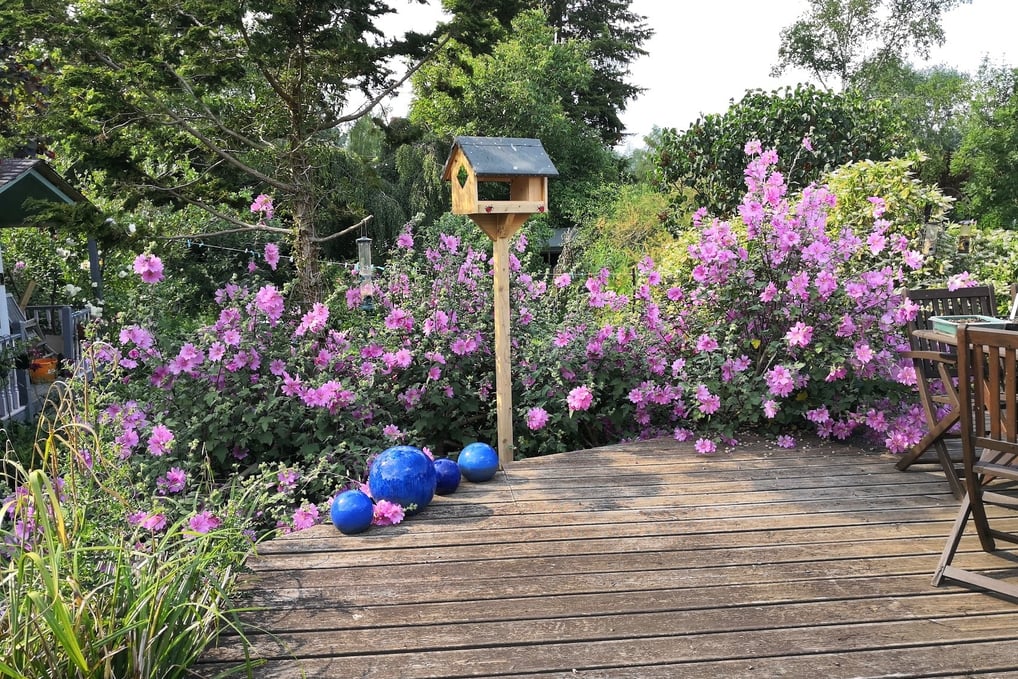

Photo: The burying of the gas tank (Autumn 2017)
2) Bother with a boiler
At the end of 2016 our ancient oil fired boiler ('furnace' for our American friends) died. The cause of it's demise was an algal bloom in the equally ancient, single skinned oil tank which had clogged up the entire system. We went the entire Winter without central heating, not as bad as it sounds as we have a separate hot water system and our trusty Swedish solid fuel stove pumped out enough heat to keep the temperature tolerable.
We had to replace both the boiler and the oil tank. Changes in legislation meant that the position of the old tank was no longer legal (too close to the neighbouring property, no bunding etc. etc.). The only place suitable would have been in the front garden, the middle of the front garden, which to put it mildly was not ideal....
We eventually opted for an LPG system with the tank buried under the front garden... we'd been thinking about making changes there as it was mainly laid to grass with some rather boring coniferous shrubs and very little to support wildlife. The tank was installed in time for the following Winter and I set about remodelling the front garden (mainly trying to get rid of several tons of clay and flint nodules). The front garden is now a huge draw for insects, birds and other assorted wildlife.
Photo: The Front Garden, June 2017 (The tank is under the flower bed)
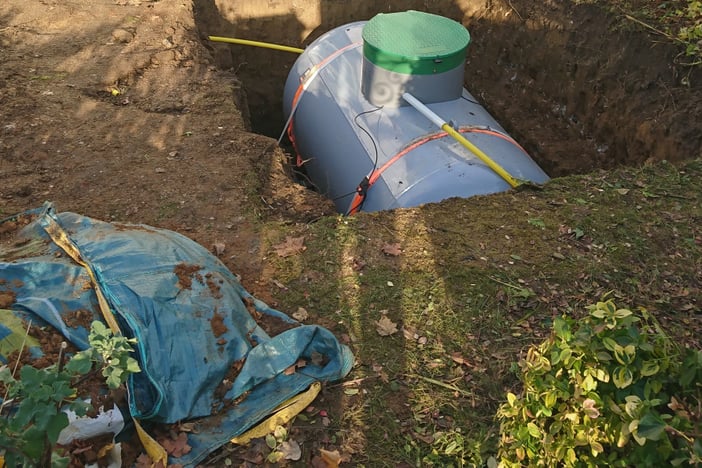



3) Oh Poo ! We said...
In the Spring of 2022 we noticed a distinct (as in distinctly unpleasant) aroma in the back garden. After much rummaging in the undergrowth we realised that we had an issue with our septic tank system, which was discharging raw sewage at ground level in the area where the soakaway was located.
We had the tank pumped out to stop any further discharges (at least temporarily) and had the system inspected using a camera. The upshot was that the rest of the system was in remarkably good condition (especially given that it was installed in 1920 when the house was built) but there was a second chamber within the main tank that was not visible from the outside, this had eventually filled up and then fed solids into the soakaway which had over time become choked up. Changes in legislation regarding waste discharge meant we could not simply have the old soakaway dug out and refilled... We needed a solution...
After consulting a number of 'experts' (some of whom were decidedly not 'expert'), we opted for a system that allowed us to continue using the existing tank but would require a new soakaway set up. The company that did the work was Mantair (https://www.mantair.com/) and came highly recommended, we too would recommend them to anyone.
The system is a unit that drops into the existing tank and effectively turns it into a sewage treatment plant, the discharge is considerably cleaner than traditional systems and is certified by The Department of the Environment (DoE) as safe to discharge into a water course (we don't but it's nice to know). The new drainage field is buried under the lawn at the depth of about 1 metre (3.5 ft).
Once the work was completed we reseeded the area with a mixture of grass, daisies and clover. As the soil settled we have been adding organic material (soil improver) to the surface which is drawn down by the worms. This is slowly filling in the dip caused by the settling and improving the soil beneath. The gallery below shows the work from start to finish (it only took two days). I should add thanks to our neighbours who allowed us to use their drive to give the digger access to our garden through the fence.
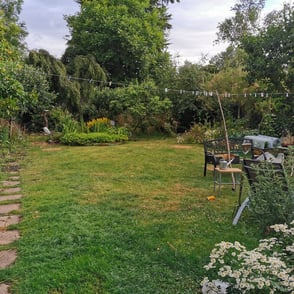
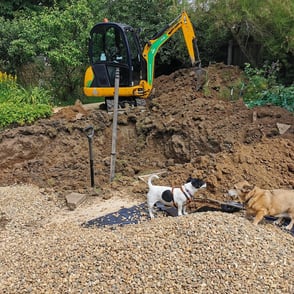
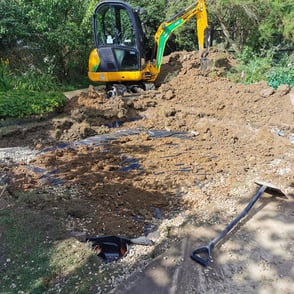
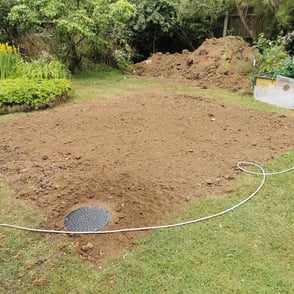
Now the changes we meant to make...
As previously mentioned the garden soil (particularly in the front garden) is largely clay so we have embarked on improving this by adding organic material. We bought in several tons to start with and now compost just about everything we can, we currently have 6 'Dalek' type composters, a hot composter for kitchen waste (even in Winter it maintains 60C) and I have started to build bigger composters made from old pallets and timber off cuts. (see the first photo in the gallery below).
I've bought a small electric wood chipper which we use to chip woody cuttings (up to 3cm in diameter) which makes a really good mulch for the flower beds. Larger wood pieces are added to the stacks we have dotted around the garden which slowly rot down and make great habitats for insects and creepy crawlies. The only organic material we don't compost are the cuttings from spiky plants and some of the more leathery leaves that don't easily rot down.
We've added a polytunnel (the photo below shows it in the process of construction), a veg plot and I've constructed several raised beds (see below). I've also constructed a ramp so that we can wheel in heavier items from the front of the house down to the garden (the picture below shows it being built). I can highly recommend getting a garden trolley (picture below shows me demonstrating ours)... ours can easily carry up to 60kg and tips which is great for moving soil.
It's not part of the garden I know but relevant to our attempts to 'green' ourselves - we had solar panels installed shortly after we moved in, for the first few years we sold the generated electricity to the grid (under a Government scheme), we have since added battery storage so we can now directly use the electricity generated and store most of the excess to use when the sun does not shine. All the power tools we use in the garden are electric which we run using our own electricity.
Last but not least we've added a potting shed and a couple more standard sheds to store gardening equipment and other bits 'n bobs.
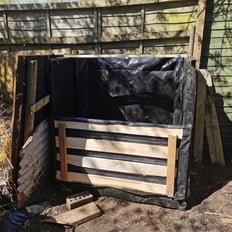

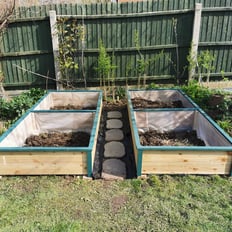
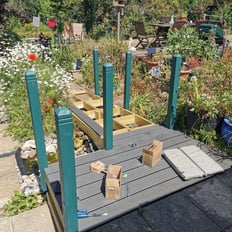
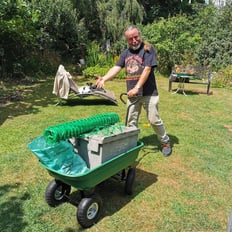
In the next part of this series I'll take a look at the plants we have in the garden... I hope you've enjoyed the story so far !
Almost forgot... '
* 'The best-laid schemes of mice and men gang aft agley' is from Robert Burns 'To a Mouse' and roughly translates as 'The best-laid plans of mice and men often go awry'
